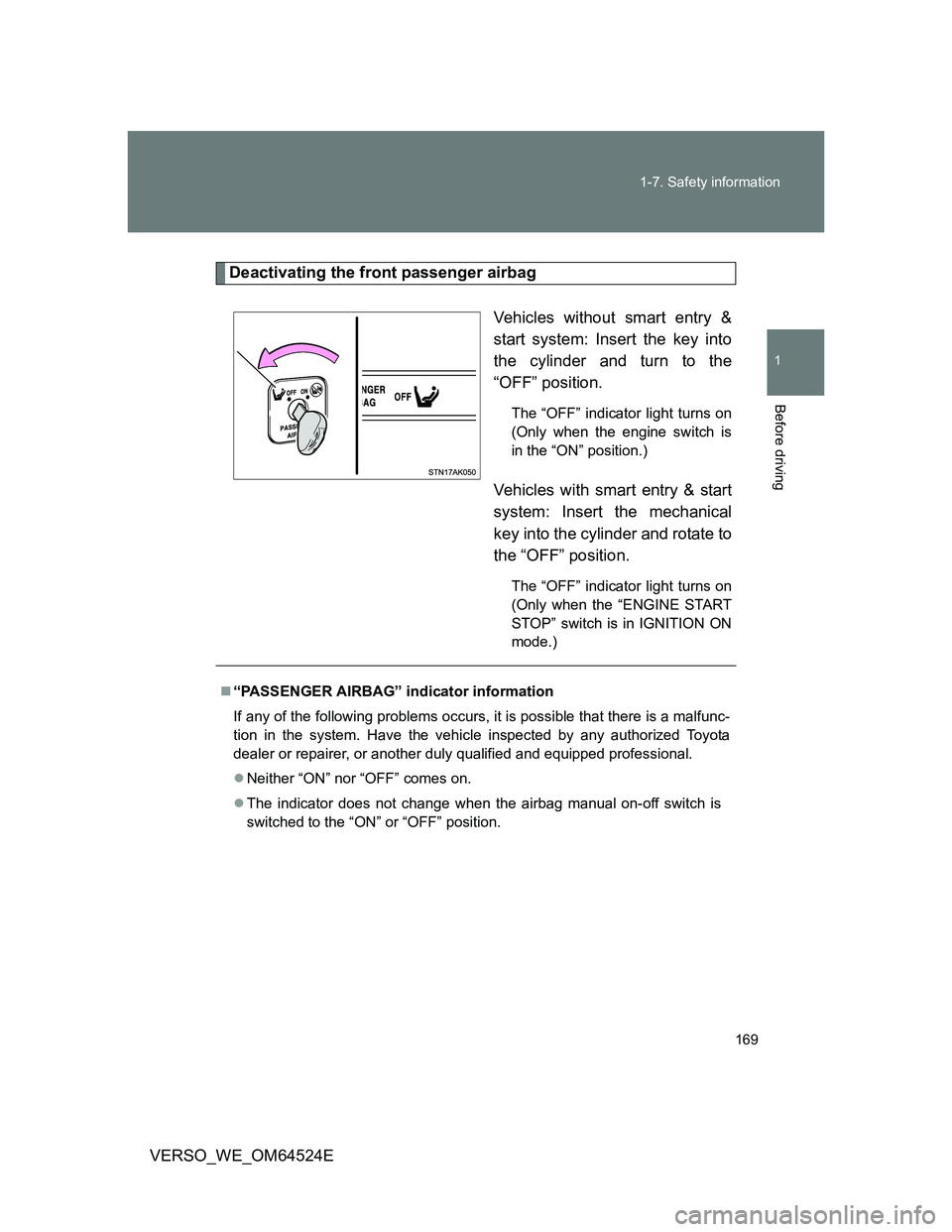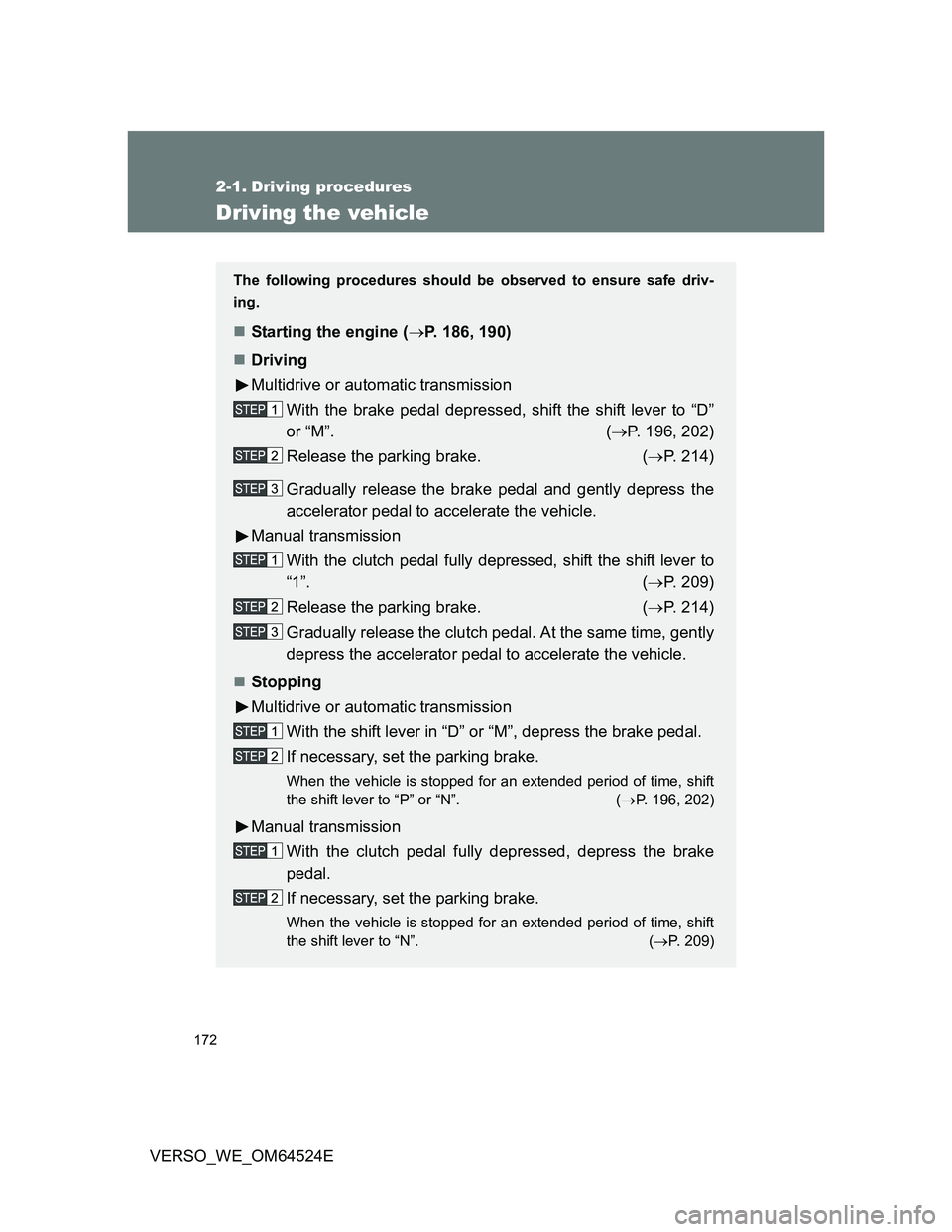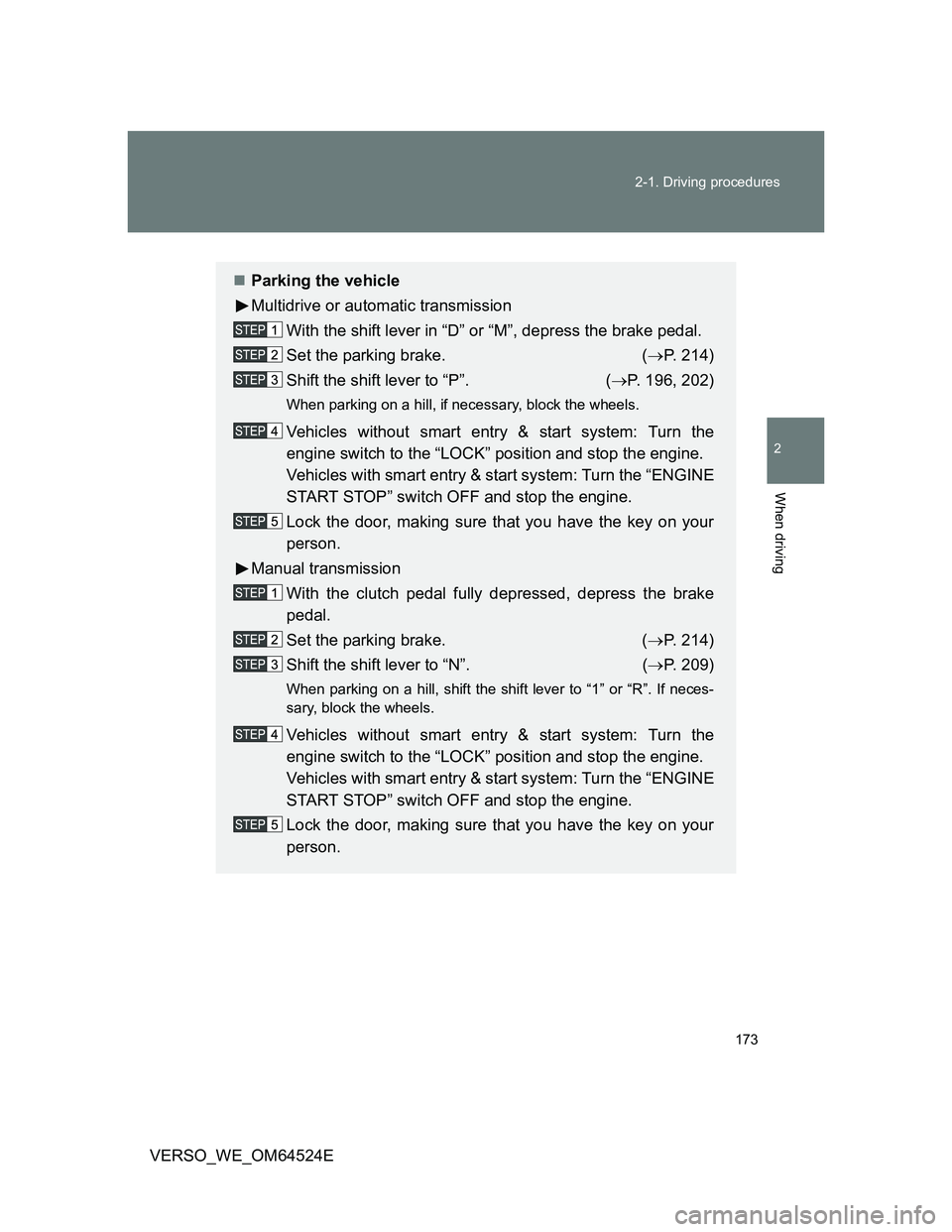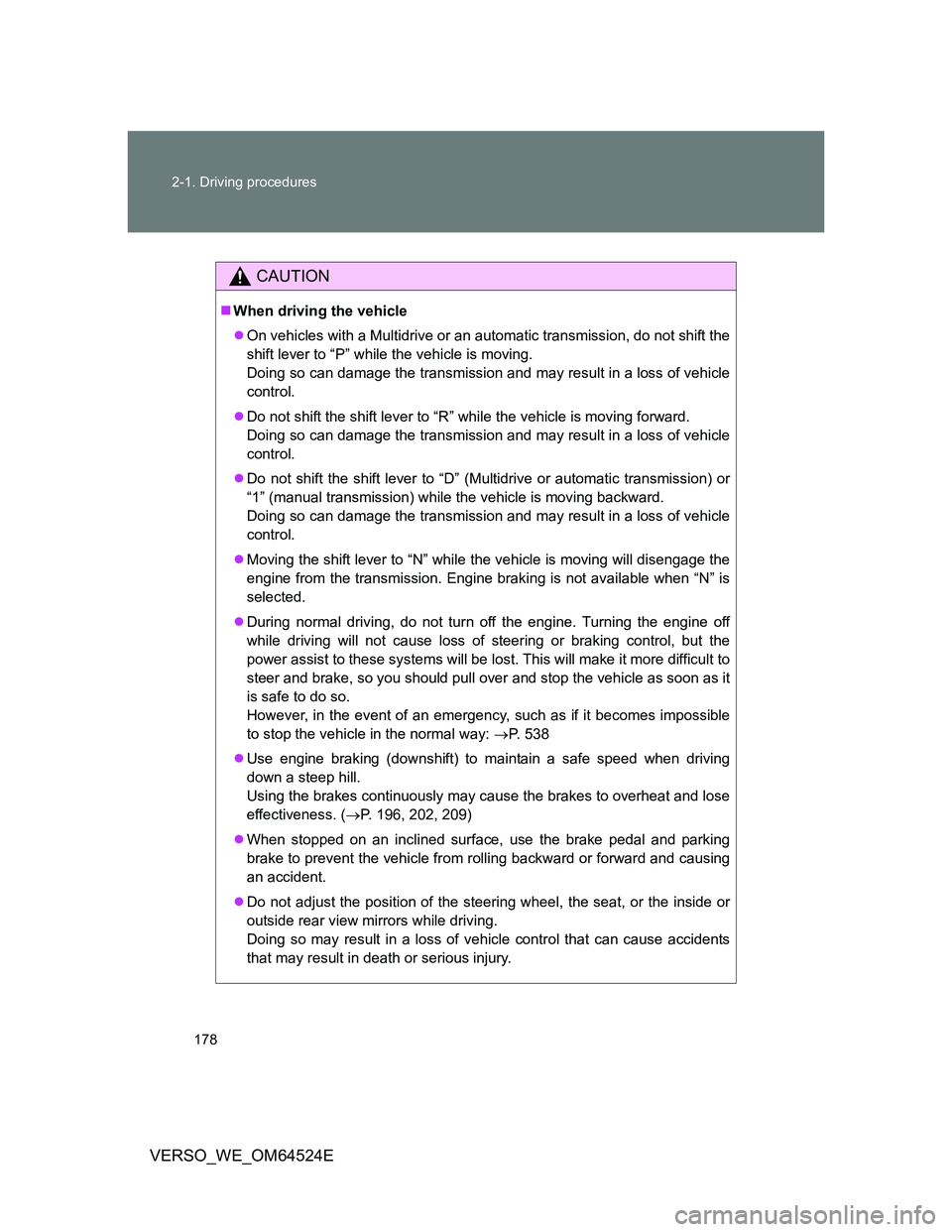2012 TOYOTA VERSO engine
[x] Cancel search: enginePage 169 of 588

169 1-7. Safety information
1
Before driving
VERSO_WE_OM64524E
Deactivating the front passenger airbag
Vehicles without smart entry &
start system: Insert the key into
the cylinder and turn to the
“OFF” position.
The “OFF” indicator light turns on
(Only when the engine switch is
in the “ON” position.)
Vehicles with smart entry & start
system: Insert the mechanical
key into the cylinder and rotate to
the “OFF” position.
The “OFF” indicator light turns on
(Only when the “ENGINE START
STOP” switch is in IGNITION ON
mode.)
“PASSENGER AIRBAG” indicator information
If any of the following problems occurs, it is possible that there is a malfunc-
tion in the system. Have the vehicle inspected by any authorized Toyota
dealer or repairer, or another duly qualified and equipped professional.
Neither “ON” nor “OFF” comes on.
The indicator does not change when the airbag manual on-off switch is
switched to the “ON” or “OFF” position.
Page 171 of 588

2When driving
171
VERSO_WE_OM64524E
2-1. Driving procedures
Driving the vehicle ............ 172
Engine (ignition) switch
(vehicles without smart
entry & start system)....... 186
Engine (ignition) switch
(vehicles with smart
entry & start system)....... 190
Multidrive .......................... 196
Automatic transmission .... 202
Manual transmission......... 209
Turn signal lever ............... 213
Parking brake ................... 214
Horn .................................. 216
2-2. Instrument cluster
Gauges and meters .......... 217
Indicators and warning
lights ............................... 222
Multi-information display ... 226
2-3. Operating the lights and
wipers
Headlight switch ............... 239
Fog light switch ................. 244
Windshield wipers and
washer ............................ 246
Rear window wiper and
washer ............................ 2512-4. Using other driving systems
Cruise control.................... 252
Speed limiter ..................... 256
Toyota parking
assist-sensor .................. 259
Driving assist systems ...... 267
Hill-start assist control....... 273
2-5. Driving information
Cargo and luggage ........... 275
Winter driving tips ............. 278
Trailer towing .................... 282
Page 172 of 588

172
VERSO_WE_OM64524E
2-1. Driving procedures
Driving the vehicle
The following procedures should be observed to ensure safe driv-
ing.
Starting the engine (P. 186, 190)
Driving
Multidrive or automatic transmission
With the brake pedal depressed, shift the shift lever to “D”
or “M”. (P. 196, 202)
Release the parking brake. (P. 214)
Gradually release the brake pedal and gently depress the
accelerator pedal to accelerate the vehicle.
Manual transmission
With the clutch pedal fully depressed, shift the shift lever to
“1”. (P. 209)
Release the parking brake. (P. 214)
Gradually release the clutch pedal. At the same time, gently
depress the accelerator pedal to accelerate the vehicle.
Stopping
Multidrive or automatic transmission
With the shift lever in “D” or “M”, depress the brake pedal.
If necessary, set the parking brake.
When the vehicle is stopped for an extended period of time, shift
the shift lever to “P” or “N”. (P. 196, 202)
Manual transmission
With the clutch pedal fully depressed, depress the brake
pedal.
If necessary, set the parking brake.
When the vehicle is stopped for an extended period of time, shift
the shift lever to “N”. (P. 209)
Page 173 of 588

173 2-1. Driving procedures
2
When driving
VERSO_WE_OM64524E
Parking the vehicle
Multidrive or automatic transmission
With the shift lever in “D” or “M”, depress the brake pedal.
Set the parking brake. (P. 214)
Shift the shift lever to “P”. (P. 196, 202)
When parking on a hill, if necessary, block the wheels.
Vehicles without smart entry & start system: Turn the
engine switch to the “LOCK” position and stop the engine.
Vehicles with smart entry & start system: Turn the “ENGINE
START STOP” switch OFF and stop the engine.
Lock the door, making sure that you have the key on your
person.
Manual transmission
With the clutch pedal fully depressed, depress the brake
pedal.
Set the parking brake. (P. 214)
Shift the shift lever to “N”. (P. 209)
When parking on a hill, shift the shift lever to “1” or “R”. If neces-
sary, block the wheels.
Vehicles without smart entry & start system: Turn the
engine switch to the “LOCK” position and stop the engine.
Vehicles with smart entry & start system: Turn the “ENGINE
START STOP” switch OFF and stop the engine.
Lock the door, making sure that you have the key on your
person.
Page 176 of 588

176 2-1. Driving procedures
VERSO_WE_OM64524E
Eco-friendly driving (vehicles with Eco Driving Indicator Light)
Idling time before engine stop (diesel engine)
To prevent damage to the turbocharger, allow the engine to idle immediately
after high-speed driving or hill climbing.
Operating your vehicle in a foreign country
Comply with the relevant vehicle registration laws and confirm the availability
of the correct fuel. (P. 547)
During Eco-friendly acceleration (Eco
driving), Eco Driving Indicator Light will
turn on. When the acceleration exceeds
Zone of Eco driving, and when the vehicle
is stopped, the light turns off.
Eco Driving Indicator Light will not oper-
ate in any of the following conditions:
The shift position is anything other than
“D”.
The driving mode is set to “SPORT”
mode. (P. 197, 203)
The paddle shift switch is operated
while the shift position is “D”.
The vehicle speed is approximately 130
km/h (80 mph) or higher.
Eco Driving Indicator Light can be acti-
vated or deactivated. (P. 235)
Driving conditionIdling time
Normal city driving Not necessary
High-speed driv-
ingConstant speed of approx.
80 km/h (50 mph)Approximately 20
seconds
Constant speed of approx.
100 km/h (62 mph)Approximately 1 minute
Steep hill driving or continuous driving at 100
km/h (62 mph) or more (race track driving etc.)Approximately 2
minutes
Page 177 of 588

177 2-1. Driving procedures
2
When driving
VERSO_WE_OM64524E
CAUTION
When starting the vehicle (vehicles with a Multidrive or an automatic
transmission)
Always keep your foot on the brake pedal while stopped with the engine run-
ning. This prevents the vehicle from creeping.
When driving the vehicle
Do not drive if you are unfamiliar with the location of the brake and accel-
erator pedals to avoid depressing the wrong pedal.
• Accidentally depressing the accelerator pedal instead of the brake
pedal will result in sudden acceleration that may lead to an accident
that could result in death or serious injury.
• When backing up, you may twist your body around, leading to a diffi-
culty in operating the pedals. Make sure to operate the pedals properly.
• Make sure to keep a correct driving posture even when moving the
vehicle only slightly, allowing you to depress the brake and accelerator
pedals properly.
• Depress the brake pedal using your right foot. Depressing the brake
pedal using your left foot may delay response in an emergency, result-
ing in an accident.
Do not drive the vehicle over or stop the vehicle near flammable materials.
The exhaust system and exhaust gases can be extremely hot. This may
cause a fire if there is any flammable material nearby.
Vehicles with a Multidrive or an automatic transmission: Do not let the
vehicle roll backwards while the shift lever is in a driving position, or roll
forward while the shift lever is in “R”.
Doing so may cause the engine to stall or lead to poor brake performance,
resulting in an accident or damage to the vehicle.
If the smell of exhaust is noticed inside the vehicle, open the windows and
check that the back door is closed.
Large amounts of exhaust in the vehicle can cause driver drowsiness and
an accident, resulting in death or a serious health hazard. Have the vehi-
cle inspected by any authorized Toyota dealer or repairer, or another duly
qualified and equipped professional immediately.
Page 178 of 588

178 2-1. Driving procedures
VERSO_WE_OM64524E
CAUTION
When driving the vehicle
On vehicles with a Multidrive or an automatic transmission, do not shift the
shift lever to “P” while the vehicle is moving.
Doing so can damage the transmission and may result in a loss of vehicle
control.
Do not shift the shift lever to “R” while the vehicle is moving forward.
Doing so can damage the transmission and may result in a loss of vehicle
control.
Do not shift the shift lever to “D” (Multidrive or automatic transmission) or
“1” (manual transmission) while the vehicle is moving backward.
Doing so can damage the transmission and may result in a loss of vehicle
control.
Moving the shift lever to “N” while the vehicle is moving will disengage the
engine from the transmission. Engine braking is not available when “N” is
selected.
During normal driving, do not turn off the engine. Turning the engine off
while driving will not cause loss of steering or braking control, but the
power assist to these systems will be lost. This will make it more difficult to
steer and brake, so you should pull over and stop the vehicle as soon as it
is safe to do so.
However, in the event of an emergency, such as if it becomes impossible
to stop the vehicle in the normal way: P. 538
Use engine braking (downshift) to maintain a safe speed when driving
down a steep hill.
Using the brakes continuously may cause the brakes to overheat and lose
effectiveness. (P. 196, 202, 209)
When stopped on an inclined surface, use the brake pedal and parking
brake to prevent the vehicle from rolling backward or forward and causing
an accident.
Do not adjust the position of the steering wheel, the seat, or the inside or
outside rear view mirrors while driving.
Doing so may result in a loss of vehicle control that can cause accidents
that may result in death or serious injury.
Page 179 of 588

179 2-1. Driving procedures
2
When driving
VERSO_WE_OM64524E
CAUTION
When driving the vehicle
Always check that all passengers’ arms, heads or other parts of their bod-
ies are not outside the vehicle, as this may result in death or serious injury.
When driving on slippery road surfaces
Sudden braking, acceleration and steering may cause tire slippage and
reduce your ability to control the vehicle, resulting in an accident.
Sudden changes in engine speed, such as engine braking caused by up-
shifting or down-shifting, may cause the vehicle to skid, resulting in an
accident.
After driving through a puddle, lightly depress the brake pedal to make
sure that the brakes are functioning properly. Wet brake pads may prevent
the brakes from functioning properly. If the brakes on only one side are wet
and not functioning properly, steering control may be affected, resulting in
an accident.
When shifting the shift lever (vehicles with a Multidrive or an automatic
transmission)
Be careful not to shift the shift lever with the accelerator pedal depressed.
This may lead to unexpected rapid acceleration of the vehicle that may
cause an accident and result in death or serious injury.
When the vehicle is stopped
Do not race the engine.
If the vehicle is in any shift positions other than “P” (Multidrive or automatic
transmission) or “N”, the vehicle may accelerate suddenly and unexpect-
edly, and may cause an accident.
Do not leave the vehicle with the engine running for a long time.
If such a situation cannot be avoided, park the vehicle in an open space
and check that exhaust fumes do not enter the vehicle interior.
Vehicles with a Multidrive or an automatic transmission: In order to prevent
accidents due to the vehicle rolling away, always keep depressing the
brake pedal while the engine is running, and apply the parking brake as
necessary.
If the vehicle is stopped on an incline, in order to prevent accidents caused
by the vehicle rolling forward or backward, always depress the brake pedal
and securely apply the parking brake as needed.